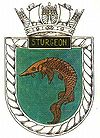.gif)
HMS Sturgeon (73S)
Encyclopedia

British S class submarine (1931)
The S-class submarines of the Royal Navy were originally designed and built during the modernisation of the submarine force in the early 1930s to meet the need for smaller boats to patrol the restricted waters of the North Sea and the Mediterranean Sea replacing the British H class submarines...
built by HM Dockyard, Chatham
Chatham Dockyard
Chatham Dockyard, located on the River Medway and of which two-thirds is in Gillingham and one third in Chatham, Kent, England, came into existence at the time when, following the Reformation, relations with the Catholic countries of Europe had worsened, leading to a requirement for additional...
. She was laid down on 1 January 1931 and was commissioned on 15 December 1932. She was one of the four submarine
Submarine
A submarine is a watercraft capable of independent operation below the surface of the water. It differs from a submersible, which has more limited underwater capability...
s that formed the First Group of the S class, and the only one of these to survive the war.
Career
Sturgeon spent most of her career in the North SeaNorth Sea
In the southwest, beyond the Straits of Dover, the North Sea becomes the English Channel connecting to the Atlantic Ocean. In the east, it connects to the Baltic Sea via the Skagerrak and Kattegat, narrow straits that separate Denmark from Norway and Sweden respectively...
, off the Scandinavia
Scandinavia
Scandinavia is a cultural, historical and ethno-linguistic region in northern Europe that includes the three kingdoms of Denmark, Norway and Sweden, characterized by their common ethno-cultural heritage and language. Modern Norway and Sweden proper are situated on the Scandinavian Peninsula,...
n coast. On September 14, 1939, she attacked her sister ship with three torpedoes but they all missed. This took place off the coast of Norway
Norway
Norway , officially the Kingdom of Norway, is a Nordic unitary constitutional monarchy whose territory comprises the western portion of the Scandinavian Peninsula, Jan Mayen, and the Arctic archipelago of Svalbard and Bouvet Island. Norway has a total area of and a population of about 4.9 million...
. Because of this incident, the Admiralty increased the operating distance of British
United Kingdom
The United Kingdom of Great Britain and Northern IrelandIn the United Kingdom and Dependencies, other languages have been officially recognised as legitimate autochthonous languages under the European Charter for Regional or Minority Languages...
submarines off Norway from 4 miles to 16 miles. She also attacked the German
Germany
Germany , officially the Federal Republic of Germany , is a federal parliamentary republic in Europe. The country consists of 16 states while the capital and largest city is Berlin. Germany covers an area of 357,021 km2 and has a largely temperate seasonal climate...
submarine , but failed to hit her. Sturgeon claimed her first success when she sank the German anti submarine trawler Gauleiter Telshow on 20 November 1939.
The sinking of the Gauleiter Telshow was the first successful attack on an enemy ship by a British submarine during the Second World War
World War II
World War II, or the Second World War , was a global conflict lasting from 1939 to 1945, involving most of the world's nations—including all of the great powers—eventually forming two opposing military alliances: the Allies and the Axis...
.
She went on to sink the German troop transport Pionier, the Danish merchant Sigrun, the Norwegian merchant Delfinus, and the German merchant Boltenhagen. She also fired six torpedoes against the , but they all missed their target.
She was one of a number of submarines ordered to track the before her eventual sinking.
HMS Sturgeon was then lent to the Royal Netherlands Navy
Royal Netherlands Navy
The Koninklijke Marine is the navy of the Netherlands. In the mid-17th century the Dutch Navy was the most powerful navy in the world and it played an active role in the wars of the Dutch Republic and later those of the Batavian Republic and the Kingdom of the Netherlands...
from 11 October 1943 to 14 September 1945. During this time, she was renamed Zeehond.
HMS Sturgeon was returned to the Royal Navy after being lent to the Royal Netherlands Navy, and then broken up at Granton in January 1946.

